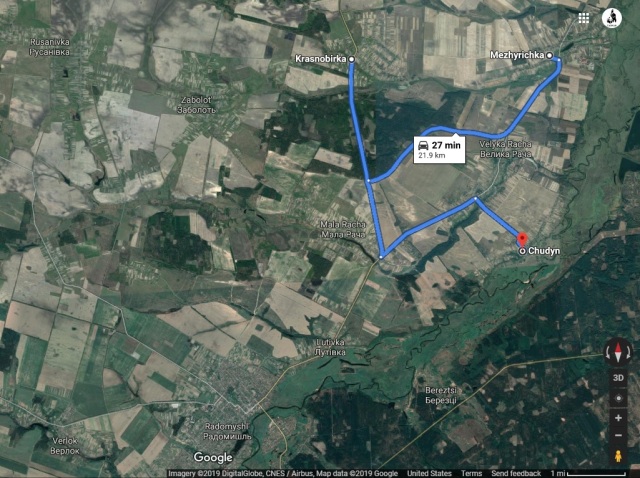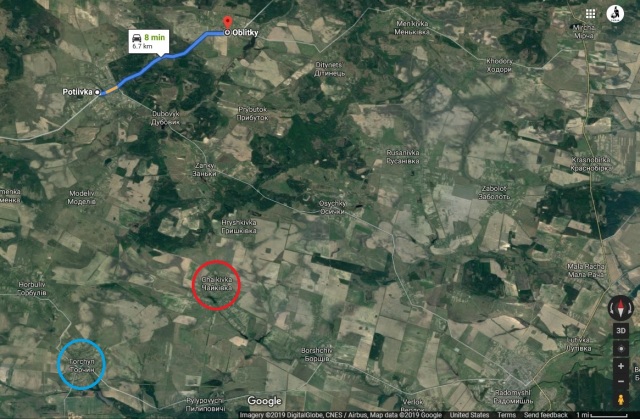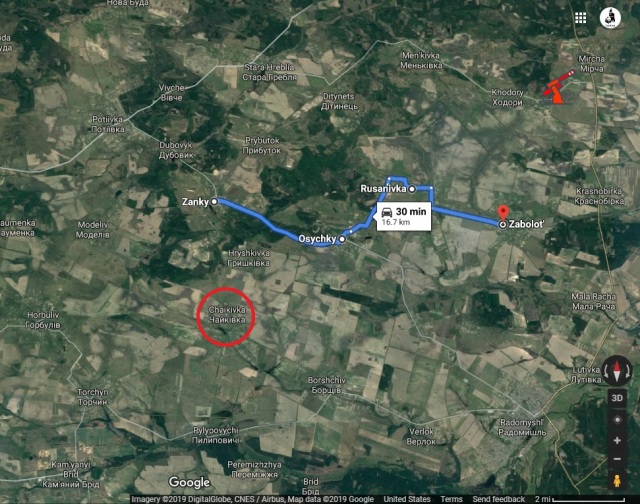***************************************
Gratitude for the interpretation efforts, by courtesy of Dmitry Benzar (Дмитрий Бензар).
***************************************
The frozen soil covered with snow. Right above it the overcast clouds hung with a height of six hundred to eight hundred meters while the wind steady blew in southeastern direction. The visibility was perfect: ten kilometers. Another good news for the Soviet artillery observers was the Luftwaffe would not show up in the course of coming day. [1]
In the late morning hours, the barrage began. But it was from the opposite side. Apparently after previous fruitless attempts to remove the Soviet bridgehead on the west bank of Teterev River, Standartenführer Wisch wanted his division to carry out next assault with more proper fire support than running “naked” through the open grounds under the cross-fires of the Soviet Paks fortified in the frontline and the heavy artillery installed along the raised east bank of the Teterev, he brought the artillery forces from his neighbor to the north, the 1. Panzer-Division, along with his own artillery units to conduct coordinated barrage against known targets around the village of Krassnoborka (Краснобірка).
When the barrage stopped at 1200 hours sharp, along with the Kampfgruppe Peiper (bulk of the SS-Panzerregiment 1), the Kampfgruppe Kraas (bulk of the SS-Panzergrenadier-Regiment 2) jumped out from their LOD hiding in the gutter northwest of Mezhyrichka (Межирічка), pushing southwest in direction on Krassnoborka, penetrated the village by 1250 hours and then turn to southeastern direction, took the Hill 170.2 at 1300 hours after destroyed eighteen Paks there. At 1515 hours, the Kampfgruppen broke into the north edge of the village of Velyka Racha (Велика Рача), whose western edge was considerably fortified by Soviet Paks, which was supposed to stop the advance of Kampfgruppe Frey (bulk of the SS-Panzergrenadier-Regiment 1). [2] During the drive over Hill 170.2 towards Velyka Racha, Untersturmführer Kalinowsky’s Tiger was hit and he was wounded in the face and nose by splinters. [3]
The 1st Guards Army reported the battle formations of the 271st Rifle Division was crushed as enemy penetrated into its defense line [4] and its 864th and 867th Rifle Regiment were retreating into the areas of Hill 179.6 and 170.2. [5]
The 107sth Rifle Corps later claimed it was attacked by at least fifty enemy tanks and two infantry battalions at 1430 hours. [6] In the contrast, at 1745 hours of 10th of December the Leibstandarte reported that fourteen tanks were serviceable under disposal of the Kampfgruppe Peiper who had as many as one hundred and fifty-six tanks under repair as a result of uninterrupted actions during previous days. [7]
By 18:00 hours, despite the success of the 328th Rifle Division who yet again repelled all the attacks against the southwestern areas of Radomyshl, securing village of Hlukhiv Pershyi (Глухов 1-й) and Hill 187.1 (north-west of Radomyshl), its right flank was already threatened as the 271st Rifle Division had withdrew to the line of Chudyn (Чудин), where the command posts of the 271st and 30th Rifle Divisions were located. [8][9]
Against Balck’s wishes, Wisch did not force his exhausted troops to execute another attack against Chudyn which reportedly was heavy occupied by the enemy. The Leibstandarte later submitted a booty report [10] of forty-two s.Paks, although the exact losses of its opponents on 11th of December was unclear so far. Since the next day, the Leibstandarte started to evacuate its damaged tanks to the repair shops in the rear. Inferring from the daily report [11] submitted by the Ia (Chief of Staff) on 12th of December, the total losses the enemy inflicted upon the Kampfgruppe Peiper on 11th of December should be three Panzer IV’s.
To this day, the counterattack of Balck’s XXXXVIII. Panzerkorps ceased in general and soon his troops would be transferred to the area of Meleni where the new challenges will be expecting them.
***************************************

The hot zone on 11th of December 1943.
***************************************
Citations:
[1] TsAMO, Fund 236, Inv 0002673, Case 0084, Pg 7. Operational Summary of the 1st Guards Army, issued at 2300 on 11.12.43.
[2] NARA T314 R1173 F188. Tagesmeldung an Pz.A.O.K. 4., announced at 1900 on 11.12.43.
[3] Patrick Agte (2006), Michael Wittmann Volume One, p. 206.
[4] TsAMO, Fund 236, Inv 0002673, Case 0084, Pg 7. Operational Summary of the 1st Guards Army, issued at 2300 on 11.12.43.
[5] TsAMO, Fund 999, Inv 1, Case 1, Pg 13. Journal of military action of the 107th Rifle Corps for December 1943.
[6] TsAMO, Fund 999, Inv 1, Case 1, Pg 14. Journal of military action of the 107th Rifle Corps for December 1943.
[7] NARA T314 R1173 F174. Ia-Tagesmeldung, announced at 1745 on 10.12.43.
[8] TsAMO, Fund 236, Inv 0002673, Case 0084, Pg 7. Operational Summary of the 1st Guards Army, issued at 2300 on 11.12.43.
[9] TsAMO, Fund 999, Inv 1, Case 1, Pg 14. Journal of military action of the 107th Rifle Corps for December 1943.
[10] NARA T314 R1173 F192. Morgenmeldung der Divisionen, recorded at 0405 on 12.12.43
[11] NARA T314 R1173 F209. Ia-Tagesmeldung, announced at 1800 on 12.12.43.
***************************************


![[燈] #改 7th (夜間) - 8th of December, Zhytomyr Oblast.](https://lavieillegarde.wordpress.com/wp-content/uploads/2019/06/e78788-e694b9-7th-e5a49ce99693-8th-of-december-zhytomyr-oblast..jpg?w=640)
![[燈] 7th (夜間) Horodchyn Городчин 前往 Chodory的路上](https://lavieillegarde.wordpress.com/wp-content/uploads/2019/06/e78788-7th-e5a49ce99693-horodchyn-d093d0bed180d0bed0b4d187d0b8d0bd-e5898de5be80-chodorye79a84e8b7afe4b88a.jpg?w=640)



